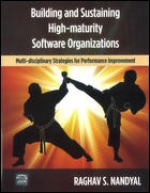Tab Article
"...In this wonderful book, Raghav Nandyal, one of the world's leading experts on process improvement, provides an informative and at times inspiring excursion into the life of true high-maturity organizations. One of the most valuable aspects of this book is Raghav's foray into measurement and statistics. ..." ---Dr. Bill Curtis, SVP and Chief Scientist, CAST
"...Following the recommendations in this book will go a long way in reducing cycle time for implementing high-process maturity practices. It will streamline organizational thinking by getting organizations to do the right things right the first time..." ---Thillai Raj T. Ramanathan, Chief Technology Officer, MIMOS Berhad
- Is it worthwhile to pursue institutionalization of high-process maturity practices?
- Is it feasible to conduct statistical analysis of software process data when such data is driven by individual and team capabilities?
- How much of statistical analysis of software measures is required to demonstrate high-process maturity?
- What is the Bruce Lee effect?
This book answers such questions and many more. Institutionalizing a high-maturity process is important, but sustaining it is impossible if the focus is only on process improvement. There are more human factors than process factors, for building and sustaining high-maturity software organizations. For most high-maturity software organizations, defining and improving the process is the easy part; sustaining it is the more difficult aspect.
Written with strong convictions on the benefits of high-process maturity in the backdrop of institutionalizing multi-disciplinary strategies, the author writes to readers who want to live the life of professional excellence; readers who pursue their objectives with a relentless focus. The hallmarks and properties of high-maturity organizations are distilled into crisp lessons. These lessons help you see beyond mere compliance with practices. They also help you determine, if an organization is truly committed to living a high-maturity life.
Process standards give you a collection of best practices that others have employed on their path to achieving greatness. Yet, unless you integrate these practices into a seamless endto-end process that you pursue and improve every day, you may not achieve the results that signify greatness. In this book, Raghav Nandyal discusses strategies to weave philosophies and methods contained in process improvement models into a life of professional excellence. The true pursuit of high-maturity is perfecting the conditions required to respond to--The Never-ending Next.
Process predictability is possible if and only if both process and workforce capability are improved to realize the Bruce Lee Effect. Intended Audience: CEOs, Senior Managers, Quality Professionals,Process Specialists and Practitioners of Software and Systems Engineering in Learning Organizations who would like to pursue a life of greatness.


